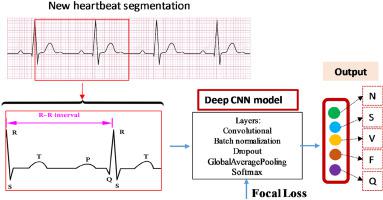Computers in Biology and Medicine ( IF 7.0 ) Pub Date : 2020-07-05 , DOI: 10.1016/j.compbiomed.2020.103866 Taissir Fekih Romdhane 1 , Haikel Alhichri 2 , Ridha Ouni 2 , Mohamed Atri 3

|
The electrocardiogram (ECG) is an effective tool for cardiovascular disease diagnosis and arrhythmia detection. Most methods proposed in the literature include the following steps: 1) denoizing, 2) segmentation into heartbeats, 3) feature extraction, and 4) classification. In this paper, we present a deep learning method based on a convolutional neural network (CNN) model. CNN models can perform feature extraction automatically and jointly with the classification step. In other words, our proposed method does not require a feature extraction step with hand-crafted techniques. Our proposed method is also based on an algorithm for heartbeat segmentation that is different from most existing methods. In particular, the segmentation algorithm defines each ECG heartbeat to start at an R-peak and end after 1.2 times the median RR time interval in a 10-s window. This method is simple and effective, as it does not use any form of filtering or processing that requires assumptions about the signal morphology or spectrum. Although enhanced ECG heartbeat classification algorithms have been proposed in the literature, they failed to achieve high performance in detecting some heartbeat categories, especially for imbalanced datasets. To overcome this challenge, we propose an optimization step for the deep CNN model using a novel loss function called focal loss. This function focuses on minority heartbeat classes by increasing their importance. We trained and evaluated our proposed model with the MIT-BIH and INCART datasets to identify five arrhythmia categories (N, S, V, Q, and F) based on the Association for Advancement of Medical Instrumentation (AAMI) standard. The evaluation results revealed that the focal loss function improved the classification accuracy for the minority classes as well as the overall metrics. Our proposed method achieved 98.41% overall accuracy, 98.38% overall F1-score, 98.37% overall precision, and 98.41% overall recall. In addition, our method achieved better performance than that of existing state-of-the-art methods.
中文翻译:

基于深层卷积神经网络和焦点损失的心电图心跳分类。
心电图(ECG)是用于心血管疾病诊断和心律不齐检测的有效工具。文献中提出的大多数方法包括以下步骤:1)去噪,2)分割为心跳,3)特征提取和4)分类。在本文中,我们提出了一种基于卷积神经网络(CNN)模型的深度学习方法。CNN模型可以自动执行特征提取,并与分类步骤一起执行。换句话说,我们提出的方法不需要手工技术进行特征提取步骤。我们提出的方法还基于与大多数现有方法不同的心跳分割算法。特别是,分段算法将每个ECG心跳定义为从R峰值开始并在1之后结束。10秒钟窗口中RR时间间隔中值的2倍。该方法简单有效,因为它不使用任何需要假设信号形态或频谱的滤波或处理形式。尽管在文献中已经提出了增强的ECG心跳分类算法,但是它们在检测某些心跳类别(尤其是针对不平衡数据集)方面未能实现高性能。为了克服这一挑战,我们提出了一种使用称为聚焦损失的新型损失函数的深层CNN模型的优化步骤。此功能通过提高少数人心跳类别的重要性来侧重于此。我们使用MIT-BIH和INCART数据集训练和评估了我们提出的模型,以识别出五个心律失常类别(N,S,V,Q,和F)基于医疗器械进步协会(AAMI)标准。评估结果表明,焦点损失函数提高了少数族裔分类的分类准确性以及整体指标。我们提出的方法实现了98.41%的总体准确度,98.38%的F1得分,98.37%的总体准确度和98.41%的整体召回率。此外,我们的方法比现有的最新方法具有更好的性能。











































 京公网安备 11010802027423号
京公网安备 11010802027423号